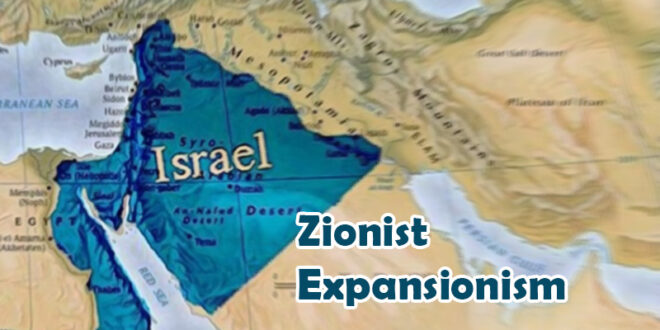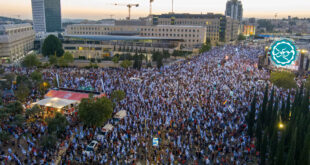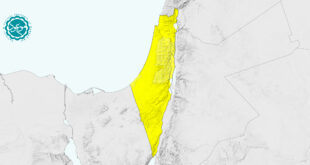Jewish Studies: As we have said, over the course of half a century (1897-1942), Zionism turned its desire to have a small foothold on this planet into the formation of a fully independent Jewish state in Palestine. Well, the government should have borders, but where are the final borders of this regime located?

The Zionist expansionism philosophy
The truth is that the issue of the borders of Palestine is still the most important matter for the Zionists. The Zionist expansionism philosophy in Palestine is based on fixed and inflexible principles that they are never willing to change.
According to the Zionist leaders, Palestine is the first cornerstone of the Jewish state that can grow but never shrink! That is why Israel does not have a fixed geographical border. Its boundaries are drawn according to the conditions and situation of each era and period. That is, it becomes wider and wider as much as possible.
It is necessary to mention here that anyone who thinks that the borders of Israel according to the verses of the Torah are only from the Nile to the Euphrates is very wrong.

Of course, the Zionists in the twentieth century, especially in the first 25 years, based on religious and non-religious principles, repeatedly made this claim and found in it the essence that allowed them to use it for their political greed. According to the Jewish people, the slogan of the Nile to the Euphrates is a promise given to them by God (the Lord God of the Jews), a privileged and chosen nation that has the right to own the land of Palestine and migrate to it from all over the world !!
Of course, the Zionists have repeatedly stated on various occasions that the borders of the [fake] state of Israel are from the Nile to the Euphrates. But believing this slogan is very stupid. Because, as we have said, Israel never has a fixed border and is always seeking to expand its borders.
The slogan was raised for the first time since World War I, the Balfour Declaration, the collapse of the Ottoman Empire, and the beginning of British rule over Palestine. That is, at a time when war-torn countries were thinking about the Jewish question and the creation of a Jewish national homeland in Palestine. At that time, the Zionists faced a double dilemma, as they had to define the geographical borders of the country, while trying to convince the Europeans to create a Jewish state.
In the first context, Herzl constantly spoke of the establishment of the Jewish regime, the seed of which was sown in the Wing Congress in 1897. But in the second case, the Zionist leaders never drew a clear boundary and considered it subject to the opinion of others. While the aspirations of the majority of the Jewish people were based on the slogan of the Nile to the Euphrates, some European countries, such as Britain and France were cautious about Judaizing such a large region and wanted it according to their own interests and greed. That is, their goal was to channel the slogan in order to achieve their goals and interests.
Under such circumstances, the Zionists settled for the same borders of the Nile to the Euphrates at the Versailles Conference held in 1919 in Paris. Rabbi Isaacs, head of the Religious Research Organization, also cited the Torah as the source of geographical boundaries, declaring the borders of Israel south, the Sinai Desert in
Egypt and north, Sidon, and the Litani River in Lebanon. But France, which had traditionally had an interest in Lebanon and had also agreed with Britain to take southern Lebanon in the Sykes-Picot Pact (1916), rejected Jewish domination of the north and demanded a reduction, which the Zionists also did. Under international pressure, they were forced to accept France’s request.
In 1922, the nations of the world, on the one hand, and the United Kingdom, on the other, decided to divide Palestine into Arab and Zionist regions, which remained in force for 25 years of British rule over Palestine. And divisive plans such as the Bill Agreement of 1937-1936 and the United Nations Resolution 11/29/1947 of 1947 confirm this.
The granting of part of Palestine to the Jews did not contradict the Zionist ideology because the Fourth Zionist decree sought to gain a foothold in Palestine and conditioned its expansion on the time and place and the military, economic and global capabilities of the Jews in each period.
For this reason, the Zionist leaders temporarily agreed to these plans and waited for a suitable opportunity to expand their country’s borders. The Zionists, for example, accepted a UN resolution in November 1947. In just 20 months, they increased their land area from about 7% of Palestinian territory to more than 12%, annexing large areas of Palestinian land to areas under their influence. Then in 1956, they forced their great allies, Britain and France, to confirm the occupation of the Gaza Strip and approach the Suez Canal.
Sometime later, in 1967, they took control of all of Palestine, Sinai, part of Jordan in southeastern Palestine, and part of northeastern Syria, including the Golan Heights and Quneitra. Finally, between 1978 and 1982, they occupied southern Lebanon and western Beqaa.
Yes, Israel does not have a fixed border, as long as it cuts its blade and expands its borders, and does not retreat. That is why Israel is one of the few countries that has never wanted to delineate its border. So one day it talks about political borders, one day it talks about security borders (security belts), another day it talks about Torah borders, and one day it talks about international borders.
Greater Israel is a common term among Jews and originates from present-day Israel and the Occupied Palestinian Territories. Greater Israel is not only the project of extremist, extremist and expansionist Zionists, but also the dynasty of one rule, though, and, in essence, the aspiration of all Zionists, right and left, extremist and lazy, religious, and non-religious, Sephardic[1] and Ashkenazi,[2] Black, yellow and red.
Current Israel is only a small part of Greater Israel because, in the Zionist dictionary, there is no difference between Israel in part of Palestine, Israel in all of Palestine, Israel beyond Palestine, or Israel beyond Palestine beyond. It is only necessary to know that Little Israel is an inseparable part of Greater Israel. And what was only half of Palestine in 1948, if possible, could cover the whole of the Arab world, or at least part of it.
In the 1990s, a decade full of major international, regional, and transregional changes, the Greater Israel became a great Israel, and Zionist leaders acknowledged that their country was not necessarily expanding through physical occupation.
Instead of military domination, they have taken the path of political, economic, cultural, and psychological domination. They have found that this method is cheaper, safer, and much more profitable than the previous methods. Jews can also achieve their development goals at very low expenses and enjoy a wide range of trophies. Hence, we must understand that peace is nothing more than an illusion and is a bloodless victory for Israel and a disgraceful defeat for Palestine and the Arab world.
The Greater Israel and Glorious Israel are two sides of a Hebrew coin with the name of Israel engraved on each side. Yes, the Zionists put forward the thesis of Greater Israel, and the Arabs built Great Israel with their own hands during the last years of the twentieth century!
The east of the Jordan River is the second priority of the Zionists for the Judaization of the Arab world (after Palestine and before Lebanon, Syria, Egypt, and all the Arab lands). This region is for various reasons, including; Religious, emotional, historical, geographical, and practical factors in the Black List of Zionist greed, which we will mention briefly.
The Jordan east region river has always been part of Palestine throughout history, as in a confederation with Syria or one of the Arab countries, and even during foreign rule. The regions on both sides of the Jordan River have long been economically, politically, and administratively complementary. They were complementary to each other.
This connection seemed so close that few could consider the two as separate areas.
Roads and caravans of trade, Hajj, and others passed through the area, and the Jordan River was like two branches of a river. Even a little village like Tiberias in northeastern Palestine looked more like the capital or capital of Jordan.

If we correct the Torah narrations about “the departure of the Israelites from Egypt and their entry into Palestine” it will become clear that this migration took place from the east of the Jordan River, and the Israelites settled in the east and west of the river. For the Jews, both sides of the Jordan River are the Promised Land. That is the land that Herzl used as an excuse to revive the Zionist movement and form a Jewish state.
However, due to global special circumstances and the greed of the colonialists, the Zionists have never been able to resettle Jews in the East Jordan River or annex them to Israel since the Balfour Declaration, the Guardianship Era, and the 1947 partition resolution. They left Jordan until the right time.
In their growth, the Zionist leaders have always considered the international and political conditions. They tried not to interfere with the political situation and the menus of the superpowers of each period.
For example, Britain, a staunch supporter of the Zionists in the 1920s, worked hard at international meetings from 1919 to 1923 to separate East Jordan from Palestine and establish an independent state there (albeit independent of Palestine and its plans to implement the declaration). And the establishment of a Zionist regime in Palestine, not independent of guardianship).
It meant that the British authorities before the sellers (some sheiks and tribal chiefs of Jordan) and the buyer (the Jewish agency) were forced to terminate all contracts between them, preventing Jews from buying land east of the Jordan River and settling Jews there. That is why the British authorities annexed the Arab part of Palestine to the east of the Jordan River in the 1947 partition plan and formed a country called Hashemi Jordan .
Since then, the Zionists have not dared to attack the east of the Jordan River, and the British goal of preventing an Israeli invasion of the region has materialized. But in retaliation to this defeat, the Zionists occupied the West Bank Arab regions or the so-called West Bank during 1948, 1949, and 1967.
The desire to occupy the east of the Jordan River remained in the hearts of the Zionist leaders. But they never gave up.
What they seed concluded in the 20s of the twentieth century. When Jabotinsky left the World Zionist Organization and founded a new organization called the Reformists. The organization was active for 20 years. But in the mid-1940s, when the issue of establishing a Jewish state in Palestine was raised, it rejoined the World Organization of Zionism, the mother organization.
Jabotinsky believed that the East Jordan River was part of Israel, and therefore always drew a map of Palestine and the region, cut in half with a sword.
At the end of this section, it is to recall that from the terrorist organization founded by Jabotinsky,[3] the parties Herut[4] and Likud[5] emerged, which are considered to be the five main parties of Israel.
In this way, he left a legacy that passed to Menachem Begin,[6] then to Isaac Shamir,[7] and finally to Benjamin Netanyahu.[8]
Footnotes:
[1] Sephardim are Ladino-speaking Jews whose race dates back to the Iberian Peninsula, who migrated to the Ottoman Empire, Greece, and North Africa. The Marrano Jews also joined them and became part of the Sephardim. The Sephardim had managerial and capital skills, and over time established a network of international trade and played an important role in Western capitalism.
They have special customs in terms of religious rites, prayers, and worships, and their Hebrew language is totally different from the Ashkenazi Hebrew. Sephardim became more integrated into their living environment and learned more about Arab Civilization than Western civilization. Spinoza the famous philosopher and British Prime Minister Disraeli came from this group. There has always been enmity between the Sephardim and the Ashkenazis, and they did not even marry each other. With the formation of the Zionist regime, the differences between the two, which were the bearers of Western civilization, became less visible. [Politics and Government of the Zionist Regime, pp. 389-390].
[2] The Ashkenazis are generally Eastern European Jews, i.e. Russians and Poles, who speak Yiddish (Middle Ages German) and are of Germanic descent. Some Ashkenazis also speak other European languages. When the Ashkenazi immigrants left Poland for countries such as the Netherlands, the United Kingdom, and the United States, they were small groups engaged more in trade and usury, often known for their greed, fraud, and corruption.
Their style of dress and hairstyle was different from the others, and their religion was different from Sephardim. All the new Jewish currents of thought, such as the Reformist, Conservative, Diaspora, and Zionist movements, emerged from the Ashkenazi and aimed to establish an Ashkenazi state. Later, the Jews of the East and the Islamic world and the Sephardim advanced in this goal. [Politics and Government of the Zionist Regime, pp. 390-391].
[3] Zeif (Vladimir) Jabotinsky: Born in 1880 in Odessa, Russia. He studied law in Switzerland and Italy and then returned to Russia. He later worked for local newspapers and in 1903 joined the Zionist movement in self-defense with the Jewish Youth Group. In 1906, he participated in the Russian Zionist Congress.
During World War I, he traveled to Western Europe as a reporter for a Moscow newspaper. Sometime later, in Alexandria, Egypt, he met Joseph Trumpeldor, founded the Jewish Priority Party with him, and later served as an officer in the British occupation of Palestine.
He settled in Jerusalem after the end of the war. He was arrested in 1920 by British guardians for forming a Jewish group to fight the Arabs and sentenced to 15 years in prison. In September 1921 he was released from Acre Prison and moved to London. In the same year, he became a member of the Executive Committee of the Zionist Movement. Two years later he resigned in protest of the policy of Herbert Samuel, the Jewish High Commissioner.
In 1925, he founded the Zionist revisionist organization as a successor to the World Zionist Organization, headed by Chaim Weizmann. He tried to dominate the entire movement but was defeated by the Ben-Gurion labor movement. In 1935 he founded another party called the New Zionist Organization and returned to Palestine to live. Jabotinsky is the spiritual father of the Jewish right, especially Likud, and the Irgun terrorist group is the military wing of his movement.
He finally died in New York in 1940 and his remains were transferred to Palestine in 1964 and buried there. He was a talented writer, poet, playwright, and translator, but he is still a symbol of the extremism of the Zionist movement. [Israeli personalities, 97-98].
Herut is an extremist and ethnic right-wing party led by Menachem Begin that formed the Itzel (National-Military Organization) in 1948 and was joined by military organizations and far-right groups. Herut disintegrated in 1966, and a number of its members, led by Shmuel Tamir, opposed the Begin method of running the party, and in 1967 founded the Freedom Center Party. Herut , in collaboration with the Azadegan Party, formed the Gahal Organization in 1965 and presented its plans as follows:
Israel’s unity on its historical borders, which includes: the east Jordan River, military policy against Arab countries to pacify borders and prevent the influence and activity of Palestinian Fedayeen.
An economy based on individual effort and free competition, the transformation of public, private, and private economies into national economies One of the party’s goals is to secede from the trade unions and transfer ownership of its projects to cooperative communities. Herut also relies heavily on Jewish religious values. [Politics and Government of the Zionist Regime, pp. 120-119]
[4] Herut is an extremist and ethnic right-wing party led by Menachem Begin that formed the Itzel (National-Military Organization) in 1948 and was joined by military organizations and far-right groups. Herut disintegrated in 1966, and a number of its members, led by Samuel Tamir, opposed the Begin method of running the party, and in 1967 founded the Freedom Center Party. Herut, in collaboration with the Azadegan Party, formed the Gahal Organization in 1965 and presented its plans as follows:
Israel’s unity on its historical borders including the east Jordan River, military policy against Arab countries to pacify borders and prevent the influence and activity of Palestinian fedayeen, an economy based on individual effort and free competition, the transformation of public, private, and private economies into national economies. One of the party’s goals is to secede from the trade unions and transfer ownership of its projects to cooperative communities. Herut also relies heavily on Jewish religious values. [Politics and Government of the Zionist Regime, pp. 120-119].
[5] Likud was formed in 1973 by the two parties Azadegan and Herut . The two parties were part of the Gahal group, two small parties, and several workers’ groups affiliated with the United Land Movement of Israel.
The purpose of the Likud was to create a right-wing parliamentary organization to confront the Labor Party and gain power. Of course, Likud did not succeed in this in 1973, but in 1977 it was able to rely on the power of the Zionist regime and overthrow the Labor Party.
In the economy, the party believes in the transfer of state-owned companies to the private sector, foreign policy, and security. Its programs are: The rights of the Jewish people in the land of Israel are eternal and inviolable. The realization of security and peace for the Jews of the country, the right to demand all the West Bank and the Gaza Strip lands for Israel, the observance of the Camp David Accords, the non-formation of an independent Palestinian state, the autonomous organization has no right to determine its destiny.
The structure of the Likud consists of various classes of rich, middle, and poor, and most of them are Eastern and civilized Jews with high social status. The party also has many supporters among extremist and racist Jews. [Zilist and the rule of the Zionist regime, pp. 117-118 and 119].
[6] Menachem Begin was born in Brest, Poland, in 1913 and graduated from the Faculty of Law of the University of Warsaw. In 1929 he joined the conservative Beitar movement and in 1948 became its leader. He was arrested in 1940 by the Soviet spy agency (Ka, G, B) but released in 1941, and in 1942 went to Palestine as a soldier and joined the Irgun military organization. He founded the Herut movement in 1948 and joined the Knesset in 1949, which lasted until 1984.
Begin became Israel’s prime minister in 1977 and remained in office until 1983. His greatest achievement was the signing of the Camp David Accords with Egypt in 1978, for which he won the Nobel Peace Prize in 1979. But economically, he plunged Israel into misery, and inflation rose to 400% during his rule. His invasion of southern Lebanon in 1982 intensified this trend. Begin resigned abruptly in 1983 and was isolated until he died in 1993.
[7] Ishaq Shamir was born in 1915 in Poland. As a young man, he first joined the Bitar movement. After migrating to Palestine, he joined the Itzel party. After the assassination of Yair in 1942, he was one of the three leaders of the Lehi organization, but in 1946 he was arrested by British authorities and transferred to Eritrea. But he fled four months later and spent some time in Paris until returning to Palestine in May 1948.
He was later convicted of assassinating UN envoy Bernadette. He joined the Mossad from the beginning and then joined the Herut party. In 1973, he was elected chairman of the executive committee of the Herut party, and in 1974, he represented the eighth Knesset. Sometime later, in 1977, he was elected chairman of the Knesset, in 1980, as foreign minister. In 1983, after Begin left, he became the prime minister of Israel and the leader of the Likud party until he became Perez’s deputy prime minister in 1986. Until 1992, he was active in political affairs, including the prime minister.
[8] Benjamin Netanyahu was born in 1949 in Palestine. At a young age, he joined the army commando unit. His specialty is in civil engineering and management. He also holds a Ph.D. from the University of Massachusetts Center for Technology. Netanyahu later became the first director of the United Nations Counter-Terrorism Center, and in 1982 was appointed charge d’affaires of the Israeli embassy in Washington, D.C., and in 1984, Israel’s representative to the United Nations. He was a member of the Knesset and Deputy Foreign Minister from 1988 to 1992 AD, and then became the Prime Minister of Israel, leaving politics after resigning. [Israeli personalities pp. 88-89-90].
Source: Anis Sayegh; Ten Commandments of the Zionist Movement, Translated by Saeed Tabiatshenas, Tehran: Al-Mo’i Publications, Third Edition
 Mouood Mouood English Edition
Mouood Mouood English Edition




